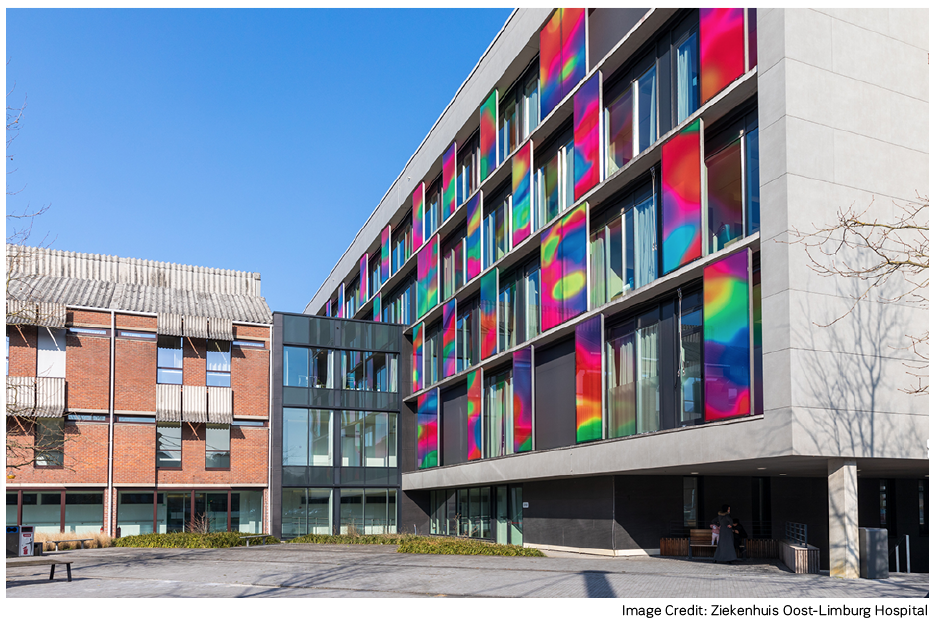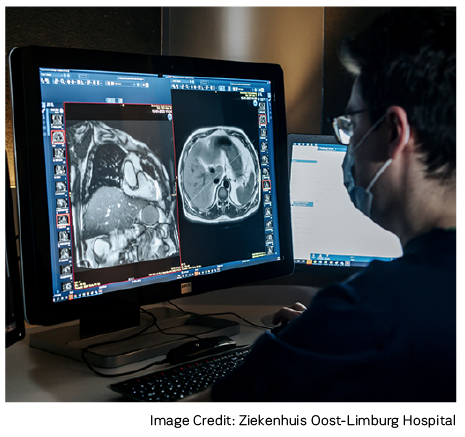HealthManagement, Volume 22 - Issue 2, 2022

Over the past few decades, the medical imaging department at Ziekenhuis Oost-Limburg (ZOL) has experienced a major transformation. With 30 radiologists on-site and four sites across Belgium (Sint-Jan in Genk, André Dumont Medical Center in Waterschei, Campus Sint-Barbara in Lanaken and Campus Maas and Kempen in Maaseik), the department has demonstrated exponential growth, having undergone numerous renovations. The hospital’s on-staff radiologists have become specialists in various disciplines. With the help of Agfa HealthCare, ZOL has implemented advanced solutions, including Enterprise Imaging for Radiology, Enterprise Imaging for Cardiology, Business Intelligence module and the XERO Viewer.
Investing in People and Technology
The medical imaging department at Ziekenhuis Oost-Limburg is one of the largest in Belgium. However, the department does not only focus on quantity but is strongly committed to quality. According to Dr. Bruno De Peuter, “we have always been very committed to quality. That means we strive to attract the best people in all disciplines – both in terms of their personality and their skill sets.”
Dr De Pueter explains how the primary driver for the renovations in medical imaging is to provide everyone with a pleasant work environment. The hospital has invested in the latest equipment and is one of the first in Belgium to install a dual-source CT scanner. The medical imaging department works with the latest and the most advanced systems for data storage and viewing. While this has required investment by the hospital, this investment has allowed the overall system to work much faster.
Centralised Worklists for Efficient Teamwork
ZOL has successfully collaborated with Agfa HealthCare for its PACS and RIS and was one of the first hospitals in Belgium to upgrade to the Enterprise Imaging Platform. Enterprise Imaging offers many advantages and has enabled the medical imaging department to create a comprehensive departmental structure that is more efficient.
“Based on queries, we can create separate, cross-site worklists for each of the subspecialties. Regardless of which ZOL site performs the exam, everything ends up in the central list, nice and tidy. If I, as a musculoskeletal radiologist, am working with MRI, I simply open the appropriate list, and I can start reading. I know exactly what to do, without having to open four or five different lists,” explains Dr De Peuter.
He points out that with the new system in place, the imaging team can read many more exams and complete them much faster. This has resulted in a more equitable division of the workload.
Standardised Work and Priorities
Dr De Peuter highlights that with Enterprise Imaging, images for each subspecialty are displayed in a standardised manner and are also available quickly, with fewer technical issues that require intervention from the IT Department. In addition, the ability to prioritise exams within the work lists is a handy functionality. For example, patients in the Emergency Departments are colour-coded red while those in the ICU are coded orange. Outpatients whose GP needs a report immediately are coded yellow. Implementing this standardised system makes it easier for radiologists to know which exams to do first without losing valuable time.
Smooth Upscaling to Four Sites
During the COVID-19 pandemic, ZOL merged with the Maas and Kempen hospital in Maaseik. This resulted in the addition of a fourth site which has had far-reaching consequences for the hospital’s imaging department.
“We were able to quickly scale up our Enterprise Imaging installation in order to integrate the site in Maaseik into our environment,” says Dr De Peuter. “The radiologists in Maaseik found it relatively easy to master Enterprise Imaging and to work within the larger ZOL environment. After a few afternoons of training, they were on their way. We were very satisfied with the training and the guidance provided by Agfa HealthCare.”
Dr De Peuter also points out that during the implementation phase and the change process, the hospital has focused on communication, transparency and team-building. This has helped prevent resistance to change. He also highlights that Enterprise Imaging is very intuitive to work with and superior to the former PACS.
Home Reporting
The COVID-19 pandemic forced the department’s healthcare workers to work from home. But as Dr Peuter describes, the Enterprise Imaging platform provided radiologists with the perfect home working environment. With the help of Agfa HealthCare, ZOL was the first hospital to work out a home-reporting set-up to enable the majority of its radiologists to work from home. Now, almost everyone has a workstation at home. These stations are identical to those in the hospital and have the same specifications and functionalities.
“We are still working partly from home today,” says Dr De Peuter. “We have noticed that working from home increases our efficiency significantly. It used to take six to eight radiologists to read 250 MRIs over the weekend; now, we can do it with only five.”
Strengthening Ties to Referrers
A major objective of implementing and upgrading the system at ZOL was to ensure the satisfaction of referring physicians, both internal and external. With the new system in place, each physician now has access to the results (images and reports) of the exam performed on their patients and receives quick assistance for any questions.
Even when radiologists have to work remotely from home, they can still communicate with colleagues and remain accessible and approachable. The imaging department at ZOL has also focused on developing subspecialties. “We must continue to prove that we are more skilled at looking at images than a surgeon in an academic hospital who only performs hip operations. That is our added value as radiologists,” says Dr De Peuter.
Radiologists are encouraged to actively participate in multidisciplinary team meetings, such as oncology consultations. This allows them to meet colleagues who make referrals, thus strengthening their ties with referrers by transparently explaining how their department works.

Management by Business Intelligence
According to Dr De Peuter, his favourite module within Enterprise Imaging is Business Intelligence (BI). He believes it helps him steer the entire department by giving him daily access to figures on the number of exams – CTs, ultrasounds, etc. – that are performed. This data enables the team to study the numbers and determine any bottlenecks.
The monthly reports also provide an excellent overview of the department’s overall performance and help identify any deviation in figures from normal usage. This allows the team to determine the cause of the deviation and take measures to correct it. For example, it was observed that only 50% of the women eligible for breast cancer screening were participating at the hospital’s Sint-Jan site. But the participation percentage was higher at the smaller sites. This allowed the department to look into whether this participation could be increased by moving breast cancer screenings to small, accessible campuses, like André Dumont.
Similarly, scheduling MRI at night provided another opportunity to improve capacity and reduce waiting times. While this could mean more work for the nursing team and more pressure, the BI module allows the monitoring of waiting times daily. If waiting times improve and are shorter than four weeks, the night exams can be paused for a while. Hence, BI can help the department identify areas of improvement and implement measures that are likely to make the operation smoother and more efficient.
Artificial Intelligence – Added Value for Radiologists
ZOL also plans to start using Artificial Intelligence (AI) on a larger scale since it is a technology that has huge potential that radiology must embrace.
ZOL does not use the cloud for image analysis for data protection reasons but is working with other hospitals to see whether forming a network could reduce the cost of acquiring AI software and paying per analysis.
At the top of ZOL’s wish list is AI for chest x-rays and mammography. Currently, mammograms are checked by two doctors at ZOL and then by a third at University Hospitals Leuven. But with a proper AI system in place, it would be possible to automatically identify mammograms that require a second reading. This could save the department a great deal of time. Specifically, Agfa HealthCare’s RUBEE packages can be quite useful as they can be completely embedded in the Enterprise Imaging work processes. That would add value compared to other packages that are stand-alone.
Digitising Imaging Orders
ZOL is also in the process of digitising imaging orders. The Belgian government wants radiologists to pre-screen requests to confirm that the appropriate exams have been ordered. This can help eliminate duplicate examinations (e.g., CT and MRI), reducing unnecessary government expenditures. However, there can be delays in making adjustments if patients submit their (paper) requests when they come to the hospital for the exam. At present, only 50% of imaging requests are received digitally via the electronic patient record. ZOL wants to increase this to 90%.
“We encourage GPs to send us their digital requests. We have also built a patient website, where patients can easily book an appointment for a radiology exam and upload a photo of the paper request. They can also specify a time for us to contact them by phone to confirm the appointment and to schedule the most suitable location. This is very handy for the patients and for our team because we have the correct patient data straight away and can provide the right care in the right place,” explains Dr De Peuter.
Disclosure of conflict of interest: Point-of-View articles are the sole opinion of the author(s) and they are part of the HealthManagement.org Corporate Engagement or Educational Community Programme.







